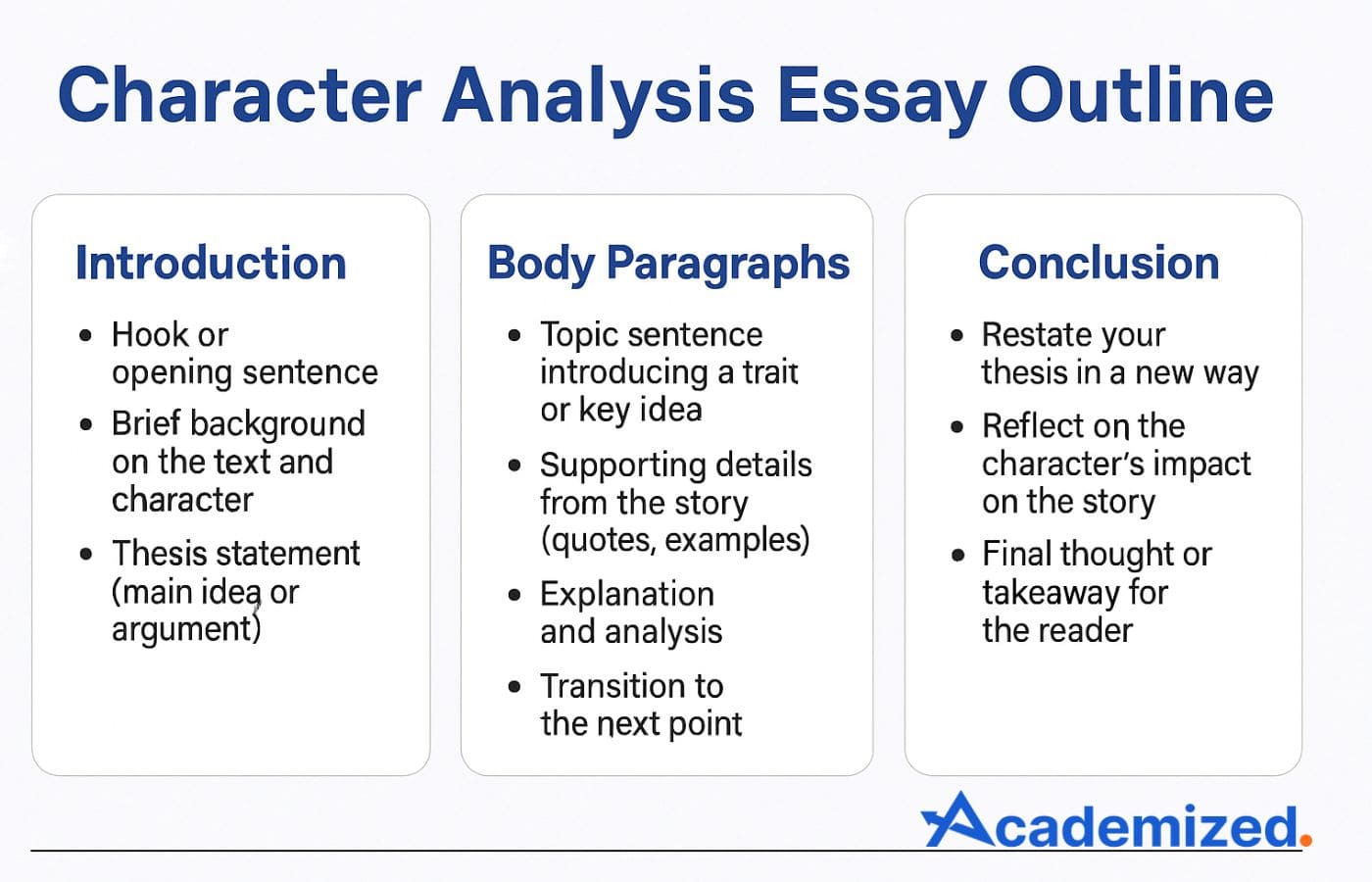- Blog
- How to Write a Character Analysis Essay That Stands Out
How to Write a Character Analysis Essay That Stands Out
 Mary Watson
Mary Watson

A character analysis essay is about diving into a specific character's details from a story and exploring their role, traits, motivations, and growth. It helps readers understand how and why a character matters within the larger plot. But what’s the best way to approach writing one? If you're wondering how to write a character analysis paper, the secret lies in going beyond surface-level traits and examining how the character evolves, connect with others, and shapes the story’s themes.
We’ve helped many students break down complex characters into clear, thoughtful essays. The key is knowing what to look for – dialogue, decisions, background, and relationships – and turning that into a structured piece of writing. Whether the character is a hero, villain, or someone else, this essay reveals what drives them and why they matter to the story.
What You Need to Know About Character Analysis Essays
A character analysis essay explores a fictional or real-life character’s traits, actions, and development throughout a story. The goal isn’t just to describe who the character is but to look deeper – examining how they think, how they grow, and how they influence the plot. You might be asked to write about a main character, someone minor, or even a group of characters. Either way, it’s all about explaining what makes them important and how their role affects the story's overall theme.
If you’ve ever wondered how to write a good character analysis essay, the answer lies in careful observation and thoughtful interpretation. These assignments are designed to help students sharpen their focus on small but meaningful details – like how a character reacts to conflict or what their dialogue reveals. By breaking down these elements, we gain insight into the text and build stronger reasoning, writing, and critical thinking skills that apply well beyond the literature classroom.
Read also: All Types of Essays: Learn How to Write Each One
Purpose of a Character Essay and What It Teaches
Looking at a character through a focused lens helps build stronger academic thinking. One of the most essential takeaways from this assignment is learning to go beyond surface-level descriptions and understand what drives a character’s choices. It’s not just about deciding if someone is “good” or “bad” – exploring their growth, struggles, and interactions with others.
There are many effective ways to write a character analysis essay, but the goal is always the same: connect traits, relationships, and key events to form a clear, meaningful interpretation. This process strengthens skills in critical reading, argument-building, and structured writing. Whether breaking down a tragic hero or spotlighting a subtle side character, every analysis sharpens your ability to think deeply about how characters reflect real-life values, challenges, and experiences.
Character Types Worth Analyzing
Every story includes characters who serve different roles – and not all need a full essay. So how do we choose? It usually starts by recognizing which character most influences the plot or theme. Some students go for the obvious choice, like the protagonist. Others dig into secondary characters who show quiet strength or unexpected growth. Here are some common types of characters often used in analysis:
- Main characters, such as heroes or protagonists, who drive the story forward
- Antagonists, who create tension and challenge the main characters
- Dynamic characters who show clear development or change
- Static characters, who stay the same but highlight the contrast in others
- Symbolic characters, who represent larger ideas or social issues
No matter which type you choose, make sure your focus stays on how the character affects the story as a whole. A well-written character analysis essay doesn't just describe what happens to a character – it explains why it matters.
How to Choose the Right Character to Analyze
Picking the right character can make writing your essay easier and more fun. A wise choice often depends on how much depth or development the character shows. Characters with clear motivations, significant changes, or complex relationships are usually the most rewarding to explore. Don’t feel pressured to go with the main character; sometimes, the side characters reveal just as much about the story. To get started, here are 10 interesting characters worth considering for a character analysis essay:
- Holden Caulfield from The Catcher in the Rye
- Elizabeth Bennet from Pride and Prejudice
- Jay Gatsby from The Great Gatsby
- Lady Macbeth from Macbeth
- Scout Finch from To Kill a Mockingbird
- Gregor Samsa from The Metamorphosis
- Celie from The Color Purple
- Winston Smith from 1984
- Offred from The Handmaid’s Tale
- Heathcliff from Wuthering Heights
And if you're still unsure where to start or how to frame your analysis, working with a professional book report writer from Academized can be smart. Expert help can guide you in choosing the right character and developing a well-organized, insightful essay that checks all the academic boxes.
Steps to Writing a Thoughtful Character Essay
Writing a character analysis doesn’t have to be confusing. Once you've picked your character, it helps to break the process into manageable steps. From reading closely to shaping your final argument, each part enables you to get closer to complete, thoughtful analysis – and it all fits into a clear character analysis essay format that keeps your ideas focused and structured.
Go Back and Revisit the Story
Start by diving into the story again, even if you think you remember it well. Pay attention to everything connected to the character – what they say, how they act, how others treat them, and what changes over time. Look for any moment that reveals who they are or how they affect the plot. The more familiar you are with the material, the easier it is to write something meaningful.
Take Notes That Matter
As you read, don’t just highlight random lines. Take notes that connect to personality traits, relationships, or changes in the character’s behavior. Note key scenes where your character makes big decisions, faces conflict, or reveals their motivations. These details will help you find evidence to support your analysis later.
Ask the Right Questions About the Character
Once you’ve got your notes, start thinking deeper. What drives this character? Do they grow or stay the same? How do they interact with others, and what does that say about their values or flaws? Asking the right questions helps you avoid summarizing the plot and instead focus on interpretation. That’s what turns a basic assignment into a strong academic essay.
Find the Main Idea Behind the Character
After digging into the details, decide what your main point will be. What does the character represent? What’s their role in the story’s message or theme? This central idea, or thesis, should guide your entire essay. Every paragraph you write should support this central point, using examples and analysis that connect back to your core message.
Read also: Step-by-Step Guide on How to Write a Visual Analysis Essay
Simple Character Analysis Essay Structure
Once you've gathered your ideas, the next step is to organize them clearly and logically. A good structure makes your points easier to follow and strengthens your overall argument. You don’t need anything complicated – just make sure your essay has three main parts: a beginning, a middle, and an end.
Start with an introduction that grabs the reader’s attention and includes a clear thesis statement. This sets the direction for your analysis. The body of your essay should contain your main points, each supported with quotes or examples from the text. Focus on one idea per paragraph to keep your writing organized and easy to understand.
Finish with a conclusion that brings everything together. Reflect on the character’s role in the story and restate your main idea in a new way. When structured this way, your essay makes sense to the reader and shows that you’ve thought carefully about your analysis.
Writing a Character Analysis Essay Outline
Outlines are helpful tools that can save you much time while writing. They keep you focused and ensure your essay stays on track from start to finish. Here's a simple structure you can follow for a character analysis essay:
Character Analysis Essay Introduction
Start with a hook that grabs the reader’s attention – this could be a thought-provoking quote, a surprising fact, or a strong statement about the character. Next, briefly introduce the story and provide context about the character you’ll analyze. End your introduction with a thesis statement that clearly expresses your main idea or argument about the character’s traits, growth, or role in the story.
Character Analysis Essay Body Paragraphs
Each body paragraph should focus on one specific character trait, theme, or aspect.
- Topic Sentence: Begin with a sentence introducing the paragraph's key point.
- Evidence from the Text: Use quotes, scenes, or dialogue illustrating the character’s behavior or development.
- Explanation: Analyze what the evidence means. What does it reveal about the character’s personality, motivations, or change over time?
- Transition: Wrap up the paragraph and smoothly lead into the next point to keep the essay flowing.
Repeat this structure for each significant trait or idea you want to discuss. Stick to two or three strong points rather than trying to cover everything about the character.
Character Analysis Essay Conclusion
Bring your analysis full circle by restating your thesis in a new way – show how your argument has been proven through the body of your essay. Reflect on the character’s role in the story and what readers can learn from them. End with a final thought that leaves a lasting impression, such as how the character connects to broader themes or real-world issues.

Insightful Character Analysis Essay Example
Character Analysis of Jay Gatsby in The Great Gatsby
Jay Gatsby, the mysterious millionaire at the center of F. Scott Fitzgerald’s The Great Gatsby, is a character built on hope, illusion, and deep longing. At first glance, Gatsby appears successful – he throws extravagant parties, drives expensive cars, and lives in a grand mansion. However, beneath the glittering surface lies a man consumed by a single goal: to recreate the past and win back Daisy Buchanan, the woman he lost years ago.
Gatsby’s fixation on the past is one of his most defining traits. He believes he can undo time and rewrite history by rebuilding his relationship with Daisy. This is clear when he tells Nick, “Can’t repeat the past? Why, of course, you can!” Gatsby is not just chasing Daisy; he is chasing a perfect version of life that never truly existed. His dream is rooted in memory, not reality, and that disconnect ultimately leads to his downfall.
Despite his wealth and charm, Gatsby is deeply isolated. Most guests who enjoy his parties know nothing about him, and very few attend his funeral. His loneliness reflects the emptiness of his pursuit. While he represents the American Dream in many ways, rising from poverty to riches, his version of that dream is hollow. He earns his fortune through questionable means and uses it to impress someone who is no longer the person he remembers.
In the end, Gatsby is a tragic figure. His determination, optimism, and refusal to abandon his dream make him admirable and flawed. He symbolizes the American Dream’s potential and dangers – how ambition and hope can become obsession and illusion. Through Gatsby, Fitzgerald explores how clinging too tightly to an idealized past can prevent us from facing the truth.
Ways to Introduce and Link Ideas in Your Analysis
Sometimes, getting started on a sentence is the hardest part. Having a few go-to phrases can make writing smoother and help your ideas flow. These expressions are not just useful – they’re part of the practical character analysis essay techniques in writing that can take your work from basic to insightful.
To introduce a trait or idea:
- One of the character’s most defining traits is...
- A key moment that reveals their personality is when...
- Throughout the story, the character shows...
To provide evidence or examples:
- This is shown when the character says...
- For instance, in Chapter 3, we see...
- An example of this behavior occurs when...
To explain or analyze:
- This suggests that...
- This shows how the character...
- This highlights the character’s struggle with...
To move between ideas:
- In addition to that...
- Another important trait is...
- As the story progresses...
Mistakes That Could Weaken Your Argument
A character analysis essay can lose direction even with a solid plan if you overlook key details. The goal is to explore who the characters are and how they contribute to the story – not just to summarize what happens. Avoid making general statements or jumping between ideas without structure. To help you stay focused, here are some common mistakes to watch out for:
- Summarizing the plot instead of analyzing the character’s personality, choices, and impact
- Forgetting to include evidence, such as direct quotes or specific scenes
- Using vague or weak language like “nice,” “mean,” or “cool” without a deeper explanation
- Analyzing too many traits and losing focus – stick with a few strong ones
- Ignoring character development, especially if they change throughout the story
- Writing a thesis for a character analysis essay that’s unclear or too broad
- Neglecting structure, making the essay feel like a list instead of a flowing argument
- Repeating the same point in different words instead of building a complete analysis
- Overusing personal opinions without linking them to the text
- Ending abruptly without a proper conclusion that reflects the character’s overall role
These common mistakes can easily throw off even the most carefully planned character analysis essay. If you’re finding it hard to stay organized, avoid vague language, or connect your points clearly, you're not alone. Using academic essay writing services from Academized can help you tackle precisely these challenges and even more. Expert writers assist in crafting a well-structured, focused essay that easily avoids common pitfalls and meets academic standards.
Academic Tips on How to Write a Character Analysis Essay
What do teachers look for in a character analysis essay? Here's what makes a difference. Original thinking stands out more than you might think – teachers can easily spot recycled ideas or summaries from the internet. Even if your point seems small, if it’s yours, it matters. A clear purpose and organized structure make your work easier to follow and more convincing. To boost your chances of a strong grade, keep these tips in mind:
- Share your ideas instead of repeating what’s already online
- Write a strong thesis statement that shows exactly what you’ll be exploring
- Organize your essay clearly, with a smooth flow from introduction to conclusion
- Proofread carefully to fix grammar, spelling, and formatting errors
- Use direct evidence from the text to back up your points
- Stick to your main idea throughout – don’t drift into unrelated details
- Avoid filler language that adds length but not value
- Focus on analysis, not just description or summary
Closing Advice and Personal Writing Tips
When I wrote my first character analysis, I made the classic mistake of repeating what happened in the story instead of digging into what it meant. Once I asked why the characters acted a certain way or how they changed, the writing became easier and more fun. I remember breaking down Atticus Finch’s calm determination in To Kill a Mockingbird and how that moment helped me connect the story to real-world ideas like fairness and justice.
If you’re stuck, start with what stands out about the character. You don’t have to say something no one’s ever said before – just be transparent and honest and back it up with the text. One of the best tips for writing a character analysis essay is to focus more on meaning than summary. These essays aren’t about perfection. They’re about learning to see people (real or fictional) more deeply. Once you practice that skill, it appears in all kinds of writing – and even how you understand others in real life.
FAQ
What’s a good way to create a thesis for a character analysis?
Think of your thesis as your main message about the character. What do they represent? How do they change? Example:
"Through her bold decisions and refusal to conform, Elizabeth Bennet challenges the gender expectations of her time."
Which techniques can I use to analyze a character?
There are five common approaches: looking at what the character says, does, thinks, how others react to them, and what the narrator reveals. Each method gives a different view of who the character is.
How should I begin my character analysis essay?
Start with a sentence that introduces the story and the character, followed by a brief idea of your focus. Example:
"In Harper Lee’s To Kill a Mockingbird, Atticus Finch stands out as a character who models moral courage in a divided community."
How do you craft a perfect character analysis essay conclusion?
End by restating your main idea and explaining the character’s more significant impact on the story or theme. Example:
"Ultimately, Atticus shows that true strength comes from standing up for what’s right, even when it’s unpopular."

Mary, our exceptional editor and online tutor, brings a wealth of knowledge to the table. With her extensive expertise in academic writing, she guides and mentors aspiring students, providing them with constructive feedback that propels their essays to the next level.


 Mary Watson
Mary Watson

